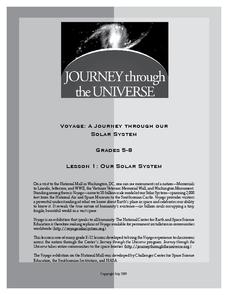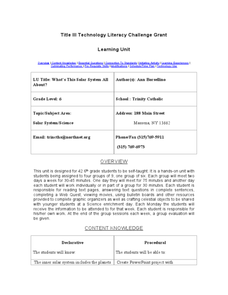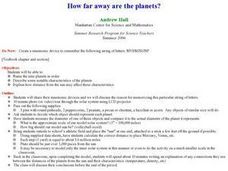University of Colorado
Looking Inside Planets
Researchers use scientific data to understand what is inside each of the planets. The first in a series of six, this instructional activity builds off of that concept by having pupils use a data table to create their own scale models of...
University of Colorado
Looking Inside Planets
All of the gas giant's atmospheres consist of hydrogen and helium, the same gases that make up all stars. The third in a series of 22, the activity challenges pupils to make scale models of the interiors of planets in order to...
Curated OER
Measurement via Triangulation
Students utilize triangulation techniques to determine altitudes of objects. An altitude locator is constructed and used to determine the height of a building or a tree. Tangent tables and formulas provide the ratio for the formula to...
Curated OER
Measurement Via Triangulation
Students investigate various common terms of measurement, sort them into categories, select the uncommon terms, and construct conversion tables for both the common and the uncommon terms of measurement.
Curated OER
Producers and Consumers
Students make lists of producers and consumers and act as consumers that eat producers in a garden. In this producers and consumers lesson plan, students demonstrate a food chain by using a piece of yarn to connect all of them together.
Curated OER
Design Space
Learners will develop an understanding design space. The arrangement of shapes is taught to create simple perspective. The differences in the size of shapes is shown in order to help learners see how they should be arranged in...
Curated OER
Describing the Planets
Young Spanish language learners review the names of each planet. Then, in pairs, they work to complete the chart provided. What is the composition of each planet? What is the color? They learn how to describe the planets.
Curated OER
Solar System Hall Model
Not novel, but fun, this activity gets your space science learners to model the size of the planets and the solar system along your school's hallway. Scaled measurements as well as actual distances are provided for both planet diameters...
Curated OER
Spelling Clue Race
Pupils decode clues in order to correctly spell words. They find clues hidden in the classroom to review for their spelling test. Perhaps this isn't the most effective way to review, but it is creative, so it's likely to capture the...
Curated OER
Famous African-American Fabric Paintings
Students examine famous African-Americans. In this African-Americans activity, students research and give an oral report on a famous African-American.
NASA
Solar System Scale & Size
Use a variety of whole fruits to represent the different planets in the solar system to introduce scale sizes to your math or space science class. They follow suit by creating a non-scaled model of the solar system using specific-colored...
Curated OER
Our Solar System
Students explain the classification of planets according to various criteria. They create charts illustrating comparative data.
Curated OER
Shakespeare: Performance First
This lesson invites students to interact with the play from their first encounter, determine actions implied from the text and better comprehend Shakespeare's language.
Curated OER
What's This Solar System All About?
Sixth graders complete a unit of lessons on the solar system. In small groups, they participate in a Webquest, watch movies, complete graphic organizers, and answer questions, create a model of the planets, and develop a Powerpoint...
Curated OER
Modeling Hot and Cold Planets
Students, in teams, design and construct models of two planets, one hot and the other cold, using a variety of materials. They attempt to create the models out of substances that will actually show the greatest temperature differences...
Curated OER
How Far Away Are the Planets?
Young scholars name nine planets in order, describe some notable characteristics of the planets, explain how distance from the sun may affect these characteristics, and create solar system models.
Curated OER
Employee Behaviors
Students demonstrate knowledge of employee behaviors that promote career success. They demonstrate knowledge of career opportunities by identifying attitudes and behaviors that strengthen the individual work ethic and promote career...
Curated OER
Moons Of The Solar System
Learners investigate the solar system and its moons. They conduct research in groups to find information. Also the teacher uses models of the planets in order to teach different facts about the solar system through the use of...
Curated OER
Exploring the Planets
Students study robotic spacecrafts that have provided detailed information about the inner and outer planets. In this exploring the planets lesson plan, students use posters and diagrams to study the various robotic spacecraft sent to...
Curated OER
Seeing Sound & Sonar
Students make inferences based on different sounds that they hear. In this inferences lesson plan, students will hear sounds of different objects and describe the sounds based on what they hear. They will answer various questions about...
Curated OER
The Solar System
Students construct a sketch of the planets in our solar system using concentric circles and angles. In this solar system lesson plan, students plot the position of each planet on concentric circles using graph paper. The sun is included...
Curated OER
Referencing the Classical Past
Students explore the concept of myths conveyed through art. In this art history activity, students examine "Three Goddesses" and discuss the state of the world at the time that Nollekens created the sculptures as they analyze the pieces.
Curated OER
Women and Sports
Young scholars examine how women in sports has changed over the years. In this women in sports lesson students research the benefits of being active.
Other popular searches
- Planet Venus
- Venus Fly Trap
- Greenhouse Effect Venus
- Mars Venus
- Observing Venus
- Mars and Venus
- Venus Lesson Plans
- Venus Return
- Solar System; Venus
- Venus Fly Trap Plants
- Venus Flytrap
- Venus Fly Trap Experiments

























